分布式计算原理与应用(Distributed_Computing)
计算机科学:十大领域的介绍与解析

计算机科学:十大领域的介绍与解析计算机科学是研究计算机系统及其使用的科学领域,涵盖了众多的子领域。
在这篇文章中,我们将介绍并解析计算机科学的十大主要领域。
1. 人工智能(Artificial Intelligence,简称AI):人工智能是计算机科学的一个分支,通过研究和开发智能软件和机器来模仿和模拟人类智能。
人工智能领域涉及到机器学习、自然语言处理、机器视觉和专家系统等技术,应用广泛,包括语音识别、图像识别、自动驾驶等。
2. 数据科学(Data Science):数据科学是研究如何从大数据集中提取有用信息的学科。
数据科学家使用数据分析、机器学习和统计学等手段,探索和发现数据背后的模式和趋势,并为决策提供支持。
数据科学在商业、医疗、金融等领域有广泛应用。
3. 网络与信息安全(Network and Information Security):网络与信息安全是确保计算机系统和数据免受未经授权访问、破坏和盗取的一系列技术和策略。
领域包括密码学、防火墙、网络入侵检测等,以确保数据的保密性、完整性和可用性。
4. 软件工程(Software Engineering):软件工程是关于开发、维护和管理软件系统的学科。
软件工程师使用系统化的方法,包括需求分析、设计、编码和测试,以确保软件的质量、可靠性和可维护性。
5. 数据库(Database):数据库是存储和组织大量数据的软件系统。
数据库管理系统负责管理和处理数据,提供高效的数据存储和检索机制,以满足用户的需求。
数据库领域包括关系数据库、分布式数据库和大数据处理等。
6. 计算机图形学(Computer Graphics):计算机图形学是研究如何通过计算机生成和处理图像的学科。
它包括三维建模、渲染、动画和图像处理等技术。
计算机图形学广泛应用于电影、电子游戏、虚拟现实等领域。
7. 计算机网络(Computer Networking):计算机网络是连接计算机和设备的物理和逻辑结构。
探索分布式计算技术的原理及应用
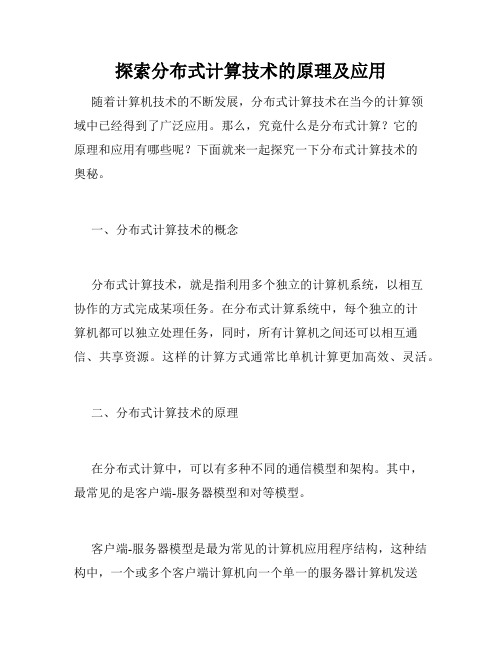
探索分布式计算技术的原理及应用随着计算机技术的不断发展,分布式计算技术在当今的计算领域中已经得到了广泛应用。
那么,究竟什么是分布式计算?它的原理和应用有哪些呢?下面就来一起探究一下分布式计算技术的奥秘。
一、分布式计算技术的概念分布式计算技术,就是指利用多个独立的计算机系统,以相互协作的方式完成某项任务。
在分布式计算系统中,每个独立的计算机都可以独立处理任务,同时,所有计算机之间还可以相互通信、共享资源。
这样的计算方式通常比单机计算更加高效、灵活。
二、分布式计算技术的原理在分布式计算中,可以有多种不同的通信模型和架构。
其中,最常见的是客户端-服务器模型和对等模型。
客户端-服务器模型是最为常见的计算机应用程序结构,这种结构中,一个或多个客户端计算机向一个单一的服务器计算机发送请求,服务器计算机则通过客户端计算机提供的参数来计算并返回结果。
而对等模型则是多个计算机系统之间进行协作完成任务。
在对等模型中,每个计算机都有相同的数据或任务,它们之间通过网络进行通信,共同完成任务。
分布式计算的实现方式,常见的有软件层面的RPC和消息传递,以及硬件层面的数据共享存储网络。
三、分布式计算技术的应用分布式计算技术在很多领域都得到广泛的应用。
下面,就来看看分布式计算技术在哪些领域有重要应用。
1.科学计算在科学计算领域,分布式计算技术可以利用多台计算机对大规模科学计算问题进行分割,将计算时间缩短到一个可行的时间范围内。
例如,对于天文学或气象学等领域的模拟计算,就需要使用大量的分布式计算资源来进行高效处理。
2.云计算分布式计算在云计算领域中也得到了广泛的应用。
通过利用云计算技术,可以将计算和存储资源集中起来,提供给用户进行使用。
云计算技术可以根据用户的需求或者工作负载自动调整计算资源的分配,提高计算和存储效率。
3.分布式存储分布式存储是分布式计算技术的一个重要方向。
通过分布式存储系统,可以利用多台计算机来协作完成数据存储操作,实现数据的共享和备份。
应用于大数据平台的分布式计算调度算法研究

应用于大数据平台的分布式计算调度算法研究随着互联网技术的快速发展,数据量的急剧增长,大数据技术得到了广泛应用。
然而,大数据的数字化处理所需的计算资源和算法调度方法却成为了一个瓶颈问题。
为了解决这个问题,我们需要研究和开发一种高效、可扩展的分布式计算调度算法,使得数据处理过程能够更加快捷、安全、可靠。
一、分布式计算调度算法的定义与目的分布式计算(Distributed Computing)是一种计算机分布式处理方式,它利用多个计算机和其各自的资源,将计算任务划分成若干个独立的子任务,由各个计算机在本地执行并最终将结果汇集在一起。
分布式计算调度算法的主要目的是将任务有效地分配到各个计算机上,并对计算资源进行合理的利用和调度,以达到任务完成的最佳效率和准确性。
在大数据处理过程中,分布式计算调度算法起到至关重要的作用。
它能够最大限度地利用庞大的集群计算资源,将数据处理任务分散到不同的计算机上并行执行,从而大大缩短数据处理时间,提高数据处理效率。
二、分布式计算调度算法的分类及特点(一)静态调度算法静态调度算法是在任务开始之前对资源进行规划,将任务分配到每个计算节点上的计算方式。
静态调度算法通常可以提供较高的效率,但计算的适应性和弹性差。
(二)动态调度算法动态调度算法是按实际需求进行资源分配和任务调度的方式。
一个动态的调度算法可以确保资源负载的均衡,并避免某些计算节点的资源利用率低下。
动态调度算法需要对系统的资源使用情况进行实时监测,以便在任何时候重新分配计算资源,从而提高系统的效率和稳定性。
(三)混合调度算法混合调度算法结合了静态调度和动态调度的优点,充分利用了不同方式的优势,以期获得更好的性能。
混合调度算法能够满足最好的性能、吞吐和延迟要求,是目前应用最普遍的调度算法。
(四)特点无论是静态调度算法还是动态调度算法,它们的特点都是多级和可扩展的。
它们需要在高级别和低级别的节点级别之间进行任务映射,并以不同的分配策略在结点之间进行任务调度。
大数据的分布式存储和计算技术

大数据的分布式存储和计算技术在信息时代,数据被视为一种新的资源,具有巨大的商业价值和战略意义,尤其是互联网时代的数据爆炸,让大数据成为了此时此刻最为热门的话题。
面对海量数据,如何存储和分析这些数据一直是个难题,直到分布式存储和计算技术的出现。
本文将阐述大数据的分布式存储和计算技术的重要性,相关技术原理及应用场景。
一、分布式存储技术分布式存储技术(Distributed Storage)是指利用计算机网络将数据存储在多个独立的节点上,使得多个节点具有相互协同的能力,形成数据存储系统。
这样的存储系统不仅能够保证数据的容错性和可用性,还能够提高系统的可扩展性和吞吐量,使得大量数据能够得以存储和处理。
分布式存储技术是众多大数据技术中的重要一环,它可以有效地解决大规模数据存储和管理问题。
目前常见的分布式存储系统有HDFS、Ceph、GlusterFS等,其中HDFS是Apache Hadoop项目中的分布式文件系统,是目前使用最为广泛的分布式存储技术之一。
在HDFS中,文件会被拆分成若干个小文件块,然后存储在不同的节点上。
每个文件块都会有多个副本进行备份,以保证数据的可靠性。
通过这种方式,HDFS不仅可以解决大规模存储的问题,还能够提供高可用、高并发和数据安全等保障措施。
二、分布式计算技术分布式计算技术(Distributed Computing)是指将整个计算任务分布到多个节点上进行处理,从而实现对海量数据的高速计算和分析。
分布式计算技术还分为两种方式:1.基于网络通信的分布式计算,如Map Reduce、Spark等;2.基于共享内存的分布式计算,如MPI等。
基于网络通信的分布式计算技术可以分布式地执行计算任务,提升计算效率和数据处理能力。
目前最流行的两个分布式计算框架是Apache Hadoop和Apache Spark,两者之间各有优点。
Hadoop基于Map-Reduce框架,可以高效地处理大量的数据切片,具有良好的数据处理性能。
深入理解分布式计算的基本原理与方法
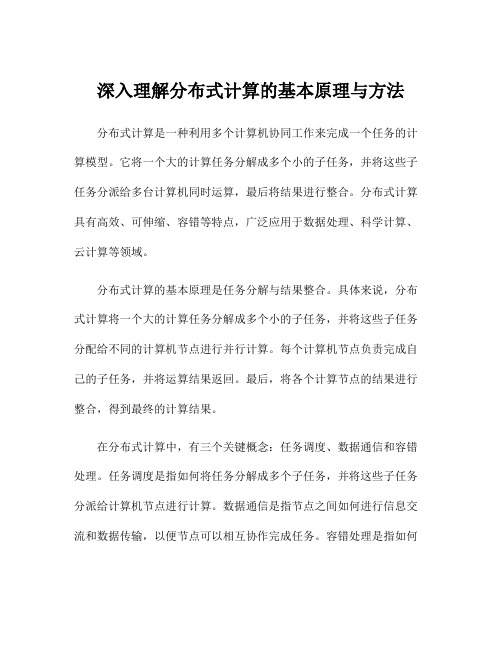
深入理解分布式计算的基本原理与方法分布式计算是一种利用多个计算机协同工作来完成一个任务的计算模型。
它将一个大的计算任务分解成多个小的子任务,并将这些子任务分派给多台计算机同时运算,最后将结果进行整合。
分布式计算具有高效、可伸缩、容错等特点,广泛应用于数据处理、科学计算、云计算等领域。
分布式计算的基本原理是任务分解与结果整合。
具体来说,分布式计算将一个大的计算任务分解成多个小的子任务,并将这些子任务分配给不同的计算机节点进行并行计算。
每个计算机节点负责完成自己的子任务,并将运算结果返回。
最后,将各个计算节点的结果进行整合,得到最终的计算结果。
在分布式计算中,有三个关键概念:任务调度、数据通信和容错处理。
任务调度是指如何将任务分解成多个子任务,并将这些子任务分派给计算机节点进行计算。
数据通信是指节点之间如何进行信息交流和数据传输,以便节点可以相互协作完成任务。
容错处理是指如何处理节点故障或通信异常等异常情况,以保证整个分布式系统的稳定性和可靠性。
在分布式计算中,有多种任务调度方式,如静态任务划分、动态任务划分和任务合作。
静态任务划分是指在任务开始之前就将任务划分成多个子任务,并在各个计算机节点上进行并行计算。
动态任务划分是指根据实际运行情况,动态地将任务划分成多个子任务,并动态地分配给计算机节点。
任务合作是指计算机节点之间相互协作,共同完成一个任务,每个节点负责计算任务中的一部分,并将计算结果传递给其他节点进行进一步计算。
数据通信在分布式计算中起着至关重要的作用。
分布式计算系统需要能够进行高效的数据传输和信息交流,以保证节点之间能够及时、准确地进行任务分发和结果传递。
为了实现高效的数据通信,可以采用消息传递机制,即通过消息传递的方式进行节点之间的通信。
消息传递可以分为同步消息传递和异步消息传递两种方式。
同步消息传递是指发送方等待接收方接收完消息后再继续执行,而异步消息传递是指发送方发送消息后立即继续执行,不等待接收方的响应。
分布式算力

分布式算力分布式算力(Distributed Computing)是指基于多台计算机互相协同工作,共同完成一个计算任务的计算模式。
它利用多个计算机的算力进行分块计算,通过数据通信、任务分配和结果集成等技术手段,实现高效、可靠的计算效果。
在分布式算力模式中,每台计算机都可以视为一个计算节点,节点之间通过网络协议进行通信和数据交换。
通常,这些节点都运行着同一个软件,在同一任务队列中协同工作,每个节点分别承担一个任务分块计算的工作,并将计算结果传递给下一个节点,最终保证任务的完成。
分布式算力有以下几个特点:1. 可扩展性。
可以通过添加更多的计算节点来增加计算能力,因此可以很容易地扩展到数千个节点,并且保证了高效的计算效果。
2. 分布性。
每个计算机都有一定的算力,在不同位置运行,因此不需要集中在同一个地方进行计算,可以分散到不同的地方完成任务。
3. 高效性。
每个计算节点可以专注于一个小的计算任务,这样可以有效地降低每个节点的负载,从而提高计算效率。
4. 可靠性。
由于每个节点都有自己的备份和容错机制,因此即使某些节点发生故障或失效,整个系统仍然可以正常执行任务,保证了计算可靠性。
需要注意的是,分布式算力不仅为科学研究、数据处理和计算机仿真等应用领域带来了巨大的便利,同时还在区块链领域中得到广泛应用。
分布式算力在区块链中的作用主要是通过挖矿来实现,挖矿就是把分布式算力提供给区块链网络,为网络提供计算能力,以便完成区块验证和交易处理等任务。
总体来说,分布式算力是一个非常有价值的计算模式,它可以极大地提高计算效率、降低计算成本,并且在多个领域都有应用和推广前景。
无疑,随着技术的进步和应用场景的拓展,分布式算力将会在未来的计算领域中发挥越来越重要的作用。
分布式系统:分析分布式系统的基本原理、技术和应用
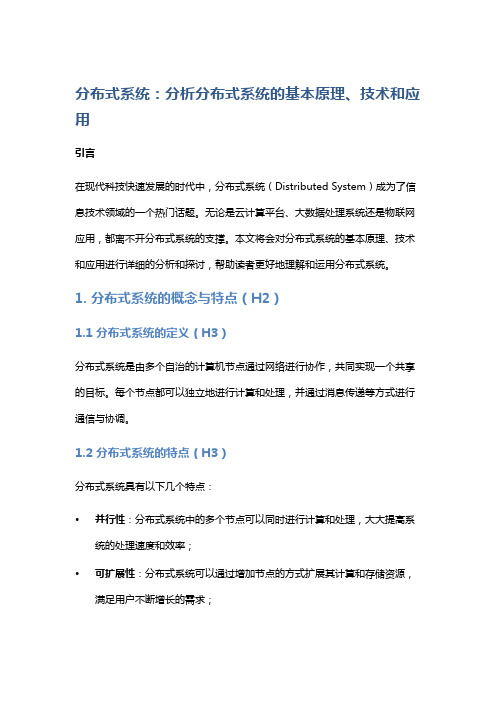
分布式系统:分析分布式系统的基本原理、技术和应用引言在现代科技快速发展的时代中,分布式系统(Distributed System)成为了信息技术领域的一个热门话题。
无论是云计算平台、大数据处理系统还是物联网应用,都离不开分布式系统的支撑。
本文将会对分布式系统的基本原理、技术和应用进行详细的分析和探讨,帮助读者更好地理解和运用分布式系统。
1. 分布式系统的概念与特点(H2)1.1 分布式系统的定义(H3)分布式系统是由多个自治的计算机节点通过网络进行协作,共同实现一个共享的目标。
每个节点都可以独立地进行计算和处理,并通过消息传递等方式进行通信与协调。
1.2 分布式系统的特点(H3)分布式系统具有以下几个特点:•并行性:分布式系统中的多个节点可以同时进行计算和处理,大大提高系统的处理速度和效率;•可扩展性:分布式系统可以通过增加节点的方式扩展其计算和存储资源,满足用户不断增长的需求;•容错性:分布式系统中的节点相互独立,即使某个节点发生故障也不会对整个系统造成影响,提高了系统的可靠性;•灵活性:分布式系统的节点可以根据需求的变化进行动态调整和重新配置,适应不同的使用场景。
2. 分布式系统的基本原理(H2)2.1 消息传递(H3)在分布式系统中,节点之间通过消息传递的方式进行通信和协作。
消息传递可以分为同步和异步两种方式:•同步消息传递:发送方将消息发送给接收方,等待接收方处理完毕后再继续执行,类似于函数调用;•异步消息传递:发送方将消息发送给接收方后立即继续执行,不等待接收方处理完毕,类似于事件订阅和发布。
2.2 一致性协议(H3)在分布式系统中,节点之间需要进行一致性协议的约定,以保证数据的一致性和可靠性。
常见的一致性协议有两阶段提交(Two-Phase Commit)和三阶段提交(Three-Phase Commit)等。
两阶段提交是指在进行分布式事务提交时,首先进行准备阶段,确认所有节点是否准备好提交事务,然后进行提交阶段,将事务提交到所有节点。
云计算技术——分布式计算(课件PPT)

2.2.1 ACID原则
2.C(Consistency)—一致性 一致性也比较容易理解,也就是说数据库要一直处于一致的状态,事务 的运行不会改变数据库原本的一致性约束。 例如现有完整性约束a + b = 10,如果一个事务改变了a,那么必须得改变 b,使得事务结束后依然满足a + b = 10,否则事务失败。
17
分区容错性
•分区容错性指“The system continues to operate despite arbitrary message loss or failure of part of the system”,也就是指分布式系统在遇到某节点或网络分区故 障的时候,仍然能够对外提供满足一致性和可用性的服务。 •分区容错性和扩展性紧密相关。在分布式应用中,可能因为一些分布式的原因 导致系统无法正常运转。好的分区容错性要求应用虽然是一个分布式系统,但 看上去却好像是一个可以运转正常的整体。例如现在的分布式系统中有某一个 或者几个机器宕掉了,其他剩下的机器还能够正常运转满足系统需求,或者是 机器之间有网络异常,将分布式系统分隔为独立的几个部分,各个部分还能维 持分布式系统的运作,这样就具有好的分区容错性。
云计算原理与实践
Principles and Practice of Cloud Computing
1
Outline
• 2.1 分布式计算概述
• 2.2 分布式计算的理论基础
• 2.3 分布式系统概述 • 2.4 分布式系统的进阶 • 2.5 典型的分布式系统
Domain expertise
Data Science
24
2.软状态
• 软状态是指允许系统存在中间状态,而该 中间状态不会影响系统整体可用性。
分布式计算的原理

分布式计算是一种计算模式,它将一个大型计算任务分解成许多小的、独立的子任务,然后将这些子任务分配给多个计算节点(通常是网络上的多台计算机)进行处理。
每个节点只负责处理任务的一部分,最后将所有节点的处理结果汇总起来,得到最终的计算结果。
分布式计算的原理主要包括以下几个方面:1. 任务分解(Task Decomposition):- 将复杂的、大规模的任务分解成小的、可管理的子任务。
这些子任务可以是独立的,也可以有一定的依赖关系。
2. 并行处理(Parallel Processing):- 在多个计算节点上并行执行这些子任务,以提高计算效率。
每个节点可以同时处理多个子任务,而且在网络条件允许的情况下,节点之间的通信也可以并行进行。
3. 资源分配(Resource Allocation):- 根据每个节点的计算能力和网络条件,合理地分配任务和资源。
这涉及到任务调度算法,它负责决定哪个节点应该执行哪个任务。
4. 数据管理(Data Management):- 管理和分配数据,确保每个节点都能访问到它所需要的数据。
这可能涉及到数据分区、数据复制和一致性维护等问题。
5. 通信协调(Communication and Coordination):- 节点之间需要通过通信来交换信息和协调任务执行。
这包括同步和异步通信机制,以及解决通信中的各种问题,如网络延迟、数据丢失和节点故障等。
6. 容错性(Fault Tolerance):- 分布式系统需要能够处理节点故障和网络分区等异常情况。
这通常通过冗余、备份和恢复机制来实现。
7. 一致性(Consistency):- 确保所有节点最终能够达到一致的计算结果。
在分布式系统中,由于节点之间的独立性,一致性是一个需要特别关注的问题。
8. 负载均衡(Load Balancing):- 动态地调整任务分配,以平衡各个节点的负载,避免某些节点过载而其他节点空闲的情况。
分布式计算的关键优势在于它能够利用分布式资源来提高计算效率和处理能力,同时也能够提高系统的可靠性和容错性。
分布式计算原理

分布式计算原理分布式计算是一种利用多台计算机协同工作来完成单个任务的计算方式。
它可以将一个大型任务分解成许多小的子任务,然后分配给不同的计算机进行处理,最终将各个计算结果合并在一起,从而完成整个任务。
分布式计算的原理是基于计算机网络和并行计算技术,它可以提高计算效率,提升系统的可靠性和可用性。
首先,分布式计算的原理之一是任务分解和分配。
在分布式计算系统中,一个大型任务会被分解成若干个小的子任务,然后这些子任务会被分配给不同的计算节点进行处理。
这样可以充分利用各个计算节点的计算资源,提高整个系统的计算效率。
其次,分布式计算的原理还包括通信和协调。
在分布式计算系统中,各个计算节点之间需要进行通信和协调,以确保它们能够有效地协同工作。
这就需要设计合适的通信协议和协调机制,以确保各个计算节点之间能够互相通信,协同完成任务。
另外,分布式计算的原理还包括容错和恢复。
在分布式计算系统中,由于涉及多台计算机,可能会出现计算节点故障或通信故障的情况。
因此,需要设计相应的容错和恢复机制,以确保系统能够在出现故障时自动进行恢复,保证系统的可靠性和可用性。
此外,分布式计算的原理还包括数据共享和一致性。
在分布式计算系统中,不同的计算节点可能需要共享数据,因此需要设计合适的数据共享机制,以确保各个计算节点之间能够共享数据,并且保持数据的一致性。
总的来说,分布式计算的原理是基于任务分解和分配、通信和协调、容错和恢复、数据共享和一致性等技术,通过这些技术来实现多台计算机的协同工作,提高计算效率,提升系统的可靠性和可用性。
分布式计算已经广泛应用于各种领域,如云计算、大数据分析、人工智能等,成为了当今计算领域的重要技术之一。
浅谈云计算技术_分布式
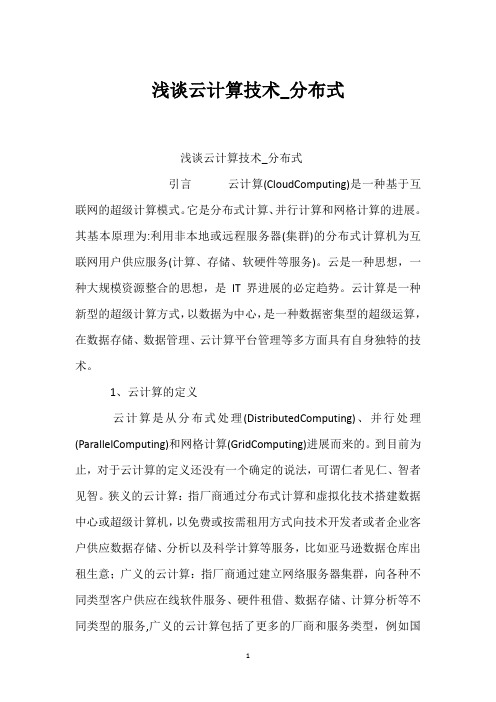
浅谈云计算技术_分布式浅谈云计算技术_分布式引言云计算(CloudComputing)是一种基于互联网的超级计算模式。
它是分布式计算、并行计算和网格计算的进展。
其基本原理为:利用非本地或远程服务器(集群)的分布式计算机为互联网用户供应服务(计算、存储、软硬件等服务)。
云是一种思想,一种大规模资源整合的思想,是IT界进展的必定趋势。
云计算是一种新型的超级计算方式,以数据为中心,是一种数据密集型的超级运算,在数据存储、数据管理、云计算平台管理等多方面具有自身独特的技术。
1、云计算的定义云计算是从分布式处理(DistributedComputing)、并行处理(ParallelComputing)和网格计算(GridComputing)进展而来的。
到目前为止,对于云计算的定义还没有一个确定的说法,可谓仁者见仁、智者见智。
狭义的云计算:指厂商通过分布式计算和虚拟化技术搭建数据中心或超级计算机,以免费或按需租用方式向技术开发者或者企业客户供应数据存储、分析以及科学计算等服务,比如亚马逊数据仓库出租生意;广义的云计算:指厂商通过建立网络服务器集群,向各种不同类型客户供应在线软件服务、硬件租借、数据存储、计算分析等不同类型的服务,广义的云计算包括了更多的厂商和服务类型,例如国内用友、金蝶等管理软件厂商推出的在线财务软件,谷歌发布的Google应用程序套装等。
2、云计算的核心技术云计算系统运用了很多技术,其中以数据存储技术、数据管理技术、编程模型、虚拟化技术、云计算平台管理技术最为关键。
2.1数据存储技术云计算的数据存储技术主要有谷歌的非开源的(GoogleFileSystem)云计算系统由大量服务器组成,同时为大量用户服务,因此云计算系统采纳分布式存储的方式存储数据,用冗余存储的方式保证数据的牢靠性。
云计算系统中广泛使用的数据存储系统是Google的GFS和Hadoop团队开发的GFS的开源实现,GFS即Google 文件系统(GoogleFileSystem),是一个可扩展的分布式文件系统,用于大型的、分布式的、对大量数据进行访问的应用。
高性能计算的实现方法

高性能计算的实现方法高性能计算是当前科学技术领域中的一个热点和难点问题。
有着多种实现方法,如分布式计算、并行计算、量子计算等。
其中分布式计算和并行计算是高性能计算的主要实现方法。
本文将分别介绍这两种方法,并探讨其实现原理和存在的问题。
一、分布式计算分布式计算(Distributed Computing)是通过计算机网络将计算机群体中的空闲计算能力联合起来形成一个虚拟计算机,以实现高性能计算的一种方法。
其主要原理是将任务分割成若干个小任务,分配给不同的计算机进行计算,最后将结果合并为一个整体的计算结果。
分布式计算的前提是要有足够的计算机资源和可靠的通信网络。
实现分布式计算的框架有很多,如Apache Hadoop、Apache Spark等。
其中Apache Hadoop是一种分布式计算的典型框架,主要用于大数据分析和处理。
Hadoop通过分割大数据集,将分块的数据分别存储到不同的计算机和硬盘中,然后通过联合计算产生最终结果。
Hadoop主要包括HDFS(Hadoop分布式文件系统)和MapReduce两个部分。
其中HDFS是一种分布式文件系统,用于存储大数据集,而MapReduce则是一种计算模型,用于分割和分配任务。
分布式计算的优点在于可以充分利用计算机资源,提高计算效率,并且分布式计算的计算任务可以分解为多个小任务,不需要专业的高性能计算设备,只需要一台普通的计算机即可。
然而,分布式计算也存在一些问题,比如网络拥塞可能导致通信延迟过大,计算结果不准确,且难以监控和调试。
二、并行计算并行计算(Parallel Computing)是将一个大任务分解成多个子任务交由多个处理单元并行执行的一种计算方法。
其优点在于在较短时间内处理大量的数据,提高了运算速度。
并行计算也是实现高性能计算的重要手段。
常见的并行计算模式有SPMD模式、MPMD模式等。
并行计算的实现方式有很多,比如使用多线程、OpenMP、MPI等。
数据中心中的高性能计算与分布式计算技术

数据中心中的高性能计算与分布式计算技术在当今信息技术迅速发展的时代,数据中心成为了企业和组织管理和存储大规模数据的重要基础设施。
数据中心不仅需要具备高性能计算的能力,还需要利用分布式计算技术来实现数据的快速处理和存储。
本文将重点介绍数据中心中的高性能计算与分布式计算技术,并探讨它们在如今大数据时代的重要性以及应用前景。
一、高性能计算技术在数据中心中的应用高性能计算(High Performance Computing,HPC)是指通过利用并行计算和超级计算机等技术手段,提供超过传统计算机性能限制的计算能力。
数据中心中的高性能计算技术可以极大地提升数据处理和分析的效率,促进科研、工程设计和商业决策等方面取得突破性的进展。
在数据中心中,高性能计算广泛应用于各种领域,如天气预报、气候模拟、基因测序、药物研发等。
这些应用场景对于大规模数据的计算和分析需求巨大,传统的计算机无法满足其高性能计算的要求。
而高性能计算技术通过并行计算、分布式存储和高速网络等手段,可以将这些任务并行化处理,从而提高计算速度和效率。
在高性能计算技术中,超级计算机是不可或缺的关键技术之一。
超级计算机以其强大的计算能力和巨大的存储空间,成为了数据中心中高性能计算的核心设备。
超级计算机采用了大规模并行计算的架构,其计算节点之间通过高速互连网络进行通信,能够同时处理多个任务,提升数据处理速度。
此外,高性能计算技术还支持分布式计算模型,利用多台计算机协同工作,共同完成大规模计算任务。
分布式计算技术有利于将数据分解成多个部分,并在多台计算机上同时运行,从而提高计算效率。
分布式计算还具备高可靠性和容错性,即使某个计算节点出现故障,也不会导致整个计算任务中断。
二、分布式计算技术在数据中心中的应用分布式计算(Distributed Computing)是指将一个计算任务划分为多个子任务,在不同的计算节点上并行运行,并最终合并各个子任务的结果。
分布式计算技术通过充分利用计算机集群的资源,可以实现大规模数据的快速处理和存储。
分布式计算技术的使用方法与应用场景
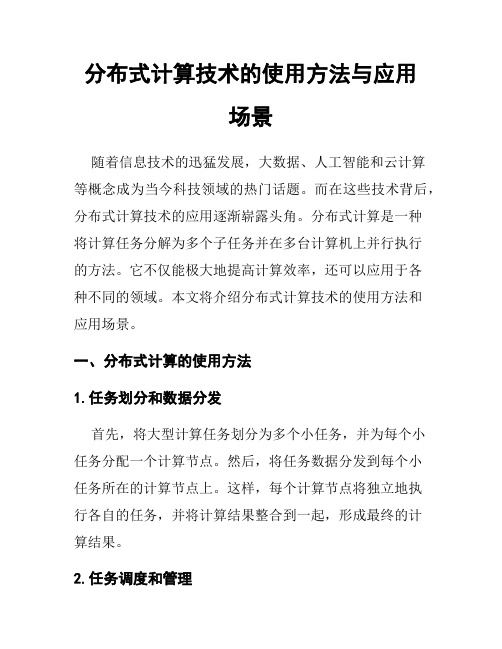
分布式计算技术的使用方法与应用场景随着信息技术的迅猛发展,大数据、人工智能和云计算等概念成为当今科技领域的热门话题。
而在这些技术背后,分布式计算技术的应用逐渐崭露头角。
分布式计算是一种将计算任务分解为多个子任务并在多台计算机上并行执行的方法。
它不仅能极大地提高计算效率,还可以应用于各种不同的领域。
本文将介绍分布式计算技术的使用方法和应用场景。
一、分布式计算的使用方法1.任务划分和数据分发首先,将大型计算任务划分为多个小任务,并为每个小任务分配一个计算节点。
然后,将任务数据分发到每个小任务所在的计算节点上。
这样,每个计算节点将独立地执行各自的任务,并将计算结果整合到一起,形成最终的计算结果。
2.任务调度和管理在分布式计算系统中,任务调度和管理是至关重要的。
它涉及到如何合理地分配计算资源,如何调度不同的计算节点执行任务以及如何处理计算节点的故障等问题。
通常,采用任务调度器来实现任务调度和管理,通过优化算法来实现任务的高效执行和计算资源的最佳利用。
3.数据通信和同步在分布式计算系统中,各个计算节点之间需要进行数据通信和同步,以确保计算结果的准确性和一致性。
常见的方法包括消息传递和共享内存等,通过这些方法,计算节点之间可以相互交换数据和同步计算状态。
二、分布式计算的应用场景1.大规模数据处理分布式计算技术特别适用于大规模数据的处理。
通过将大型数据集划分为多个小数据集,并在各个计算节点上并行处理,可以大大提高数据处理的效率。
例如,在金融领域,分布式计算可以用于高频交易数据的实时处理和分析;在生物医药领域,可以用于基因测序数据的快速分析和解读。
2.科学模拟和仿真分布式计算技术可以广泛应用于科学模拟和仿真领域。
通过将复杂的科学模型划分为多个子模型,并在分布式计算系统中并行执行,可以加快模拟和仿真的速度。
例如,在气候预测领域,可以利用分布式计算技术进行大规模的气候模拟和预测;在材料科学领域,可以利用分布式计算技术进行材料性能的模拟和优化。
分布式计算技术在虚拟现实中的应用

分布式计算技术在虚拟现实中的应用虚拟现实(VR)技术是一种可以模拟现实环境或创造虚拟世界的技术,通过使用计算机生成的图像、声音和其他感官输入,使用户能够沉浸在一个虚拟的环境中。
随着技术的发展,VR越来越受到人们的关注和重视,并在各个领域得到广泛应用,如教育、医疗、游戏等。
然而,随着VR的不断发展和应用,需要更多的计算和存储资源来支撑这些虚拟环境的构建和运行。
分布式计算技术就是一种可以为VR提供更多计算资源的技术,它可以将多个计算资源连接在一起,从而提供更强大的计算能力和存储能力。
本文将探讨分布式计算技术在虚拟现实中的应用。
一、分布式计算技术的基本原理1.数据分割:将大任务分割成多个小任务,并将这些小任务分发给不同的计算资源进行处理。
2.并行计算:利用多个计算资源同时处理任务,从而提高计算效率。
3.数据传输:在计算资源之间传输数据,确保各计算资源之间的同步和数据一致性。
4.故障处理:在一个计算资源出现故障时,能够自动将任务转移到其他计算资源上进行处理,保证计算任务的顺利完成。
虚拟现实技术需要大量的计算和存储资源来构建和运行虚拟环境,因此,分布式计算技术在VR中的应用具有重要意义。
以下是分布式计算技术在虚拟现实中的应用场景:1.图形渲染:虚拟现实技术需要大量的计算资源来进行图形渲染,以确保画面流畅和逼真。
利用分布式计算技术,可以将图形渲染任务分发给多个计算资源同时进行处理,从而提高图形渲染的速度和质量。
2.声音处理:虚拟现实技术还需要进行声音的采集、处理和合成,以模拟不同环境中的声音效果。
利用分布式计算技术,可以将声音处理任务分发给多个计算资源,并将不同计算资源合作,从而实现更加逼真的声音效果。
3.数据存储:虚拟现实技术需要大量的数据存储来存储虚拟环境中的各种信息,如图像、声音、视频等。
分布式计算技术可以将数据存储任务分发给多个计算资源,以实现高效、可靠的数据存储和管理。
4.交互体验:虚拟现实技术还需要处理用户的交互输入,如手势识别、语音识别等。
分布式计算技术在信息科学中的前沿研究与应用

分布式计算技术在信息科学中的前沿研究与应用随着信息科学的快速发展,分布式计算技术在其中发挥着越来越重要的作用。
分布式计算技术是指利用多台计算机组成的计算机网络,在不同的节点上进行任务的分解和并行处理,以提高计算效率和系统可靠性的一种技术。
本文将从分布式计算的基本原理、关键技术和应用领域等方面进行深入探讨。
一、分布式计算的基本原理和关键技术分布式计算是指将一个大型的计算任务分解为许多子任务,并将这些子任务分配给不同的计算节点进行并行处理。
分布式计算的基本原理是通过将工作任务分解为更小的部分并在多个计算节点上进行并行处理,从而提高计算速度和数据处理能力。
其中,关键技术主要包括任务分配和调度、数据分发和共享、通信和同步等。
1. 任务分配和调度任务分配和调度是分布式计算的关键技术之一。
在分布式计算环境中,将任务分配给合适的计算节点是提高计算效率的关键。
常见的任务分配算法有静态分配和动态分配两种。
静态分配是在任务开始执行之前就确定好每个计算节点要执行的任务,而动态分配则根据计算节点的负载情况实时调整任务的分配。
2. 数据分发和共享数据分发和共享是分布式计算的另一个核心技术。
在分布式计算环境中,数据的分发和共享对于任务的并行执行和结果的统一整合至关重要。
分布式文件系统和数据缓存等技术的使用可以实现节点之间的数据分发和共享,提高数据的读取和写入速度,减少数据传输的开销。
3. 通信和同步通信和同步是分布式计算中必不可少的技术。
在分布式计算环境中,节点之间需要进行通信和同步,以实现任务之间的协调和数据的传输。
常见的通信模型有同步通信和异步通信两种。
同步通信是指任务需要等待接收到其他任务的消息后才能继续执行,而异步通信则是在发送消息之后任务可以继续执行,不需要等待接收方的响应。
二、分布式计算的应用领域分布式计算技术在各个领域都有广泛的应用,下面将介绍几个典型的应用领域。
1. 科学计算分布式计算在科学计算中有着广泛的应用。
云计算(Cloud-Computing)是分布式处理(Distributed-Computing

关于“云计算"概念的资料汇总云计算(Cloud Computing)是分布式处理(Distributed Computing)、并行处理(Parallel Computing)和网格计算(Grid Computing)的发展,或者说是这些计算机科学概念的商业实现。
云计算的基本原理是,通过使计算分布在大量的分布式计算机上,而非本地计算机或远程服务器中,企业数据中心的运行将更与互联网相似。
这使得企业能够将资源切换到需要的应用上,根据需求访问计算机和存储系统.这可是一种革命性的举措,打个比方,这就好比是从古老的单台发电机模式转向了电厂集中供电的模式。
它意味着计算能力也可以作为一种商品进行流通,就像煤气、水电一样,取用方便,费用低廉。
最大的不同在于,它是通过互联网进行传输的.云计算的蓝图已经呼之欲出:在未来,只需要一台笔记本或者一个手机,就可以通过网络服务来实现我们需要的一切,甚至包括超级计算这样的任务.从这个角度而言,最终用户才是云计算的真正拥有者.云计算的应用包含这样的一种思想,把力量联合起来,给其中的每一个成员使用。
从最根本的意义来说,云计算就是利用互联网上的软件和数据的能力。
对于云计算, 李开复(现任Google全球副总裁、中国区总裁)打了一个形象的比喻:钱庄。
最早人们只是把钱放在枕头底下,后来有了钱庄,很安全,不过兑现起来比较麻烦.现在发展到银行可以到任何一个网点取钱,甚至通过ATM,或者国外的渠道。
就像用电不需要家家装备发电机,直接从电力公司购买一样.“云计算”带来的就是这样一种变革——由谷歌、IBM这样的专业网络公司来搭建计算机存储、运算中心,用户通过一根网线借助浏览器就可以很方便的访问,把“云”做为资料存储以及应用服务的中心。
目前,PC依然是我们日常工作生活中的核心工具——我们用PC处理文档、存储资料,通过电子邮件或U盘与他人分享信息.如果PC硬盘坏了,我们会因为资料丢失而束手无策。
什么是分布式计算,它们有哪些应用?

什么是分布式计算,它们有哪些应用?随着人口数量与计算机运算速度的日益增长,单个计算机无法满足大规模数据处理和分析的需求。
分布式计算应运而生,成为了当今信息科技领域中不可或缺的一部分。
下面就为大家详细解读分布式计算的概念、优点、应用以及未来的发展趋势。
一、什么是分布式计算?分布式计算是指将一个大型计算任务分成许多小任务,部署在多个计算机或节点上进行并行计算的一种计算模式。
每个节点都可以独立执行任务,并且运算结果能够汇总返回至主节点,最终获得整个计算任务的结果。
通过这种方式,分布式计算可以发挥计算机群体的整体优势,获得更高的计算性能、计算精度、计算可靠性以及计算安全性。
二、分布式计算的应用1.互联网搜索引擎互联网搜索引擎是现代互联网领域中性能要求非常高的一个应用之一。
通过使用分布式计算,搜索引擎可以在每个搜索请求中将搜索任务分成许多小任务,并使用多台计算机进行并行处理,以便更快地完成搜索任务。
2.数据挖掘和机器学习数据挖掘和机器学习需要对大量的数据进行预处理、模型训练、模型评估和结果分析。
使用分布式计算,在多个节点上进行并行处理,可以大大加快训练模型和分析数据的速度,并提升机器学习算法的准确性。
3.高性能计算高性能计算是一种需要高速计算能力和大内存处理的科学计算应用,包括天气预测、气候模拟、生物医学仿真等。
使用分布式计算,可以极大地提升计算的性能,让这些科学应用得以进行更复杂、更细致的计算模拟。
4.流媒体数据处理流媒体数据通常需要从多个数据源获取数据、对数据进行处理、传输、存储,再在最终终端进行播放。
使用分布式计算,不仅可以对这些数据进行高效的处理和传输,还可以提供更好的服务质量,更快地响应用户需求。
三、分布式计算的未来随着社交网络、物联网和大数据时代的到来,分布式计算在未来的发展前景广阔。
未来可能会出现大规模的器件网络,这样的网络将是使用若干传感器、控制器、计算机和通信装置等数千元器件并联组成的海量计算节点网络。
分布式计算的原理与应用

分布式计算的原理与应用随着数字时代的到来,数据和信息的数字化处理不断加速。
人类面临的问题推动着计算机技术的不断发展。
分布式计算作为一种新型的计算形式,应运而生,承担着处理海量数据的重任。
本文将介绍分布式计算的原理和应用。
一、分布式计算的原理分布式计算是指将一个大型计算任务分解成许多小的计算子任务,在位于不同地点的多台计算机上分别进行计算,并最终将计算结果进行汇总,得到最终的结果。
分布式计算依赖于网络通信技术和计算机并行处理技术,可实现海量数据的高效计算。
分布式计算的核心是任务分发。
它首先将大型的计算任务分解成多个小的计算子任务,然后通过互联网将这些小的计算子任务分发给不同的计算节点。
每一个计算节点会独立地计算它所分配到的计算子任务,并将计算结果返回给任务管理者。
任务管理者会在接收到所有计算节点的计算结果之后,对它们进行合并得到最终的结果。
在分布式计算中,任务管理者可以根据需要增加或减少计算节点。
计算节点可以是任何联网的计算机或功能节点,它们共同完成整个分布式计算任务。
每个节点通常只负责部分计算任务,减轻了单个计算机的计算负担,提高了整个系统的可靠性和稳定性。
由于所有的计算节点都可以进行并行计算,因此可以大大提高计算速度和效率。
同时,这也为计算任务的许多问题提供了解决方案,例如可扩展性、可靠性、容错性、负载均衡等。
同时,分布式计算还可以充分利用各节点的计算能力,每个节点可以运行不同操作系统、不同编程语言、不同硬件平台的应用程序。
这样,分布式应用可以采用最优的方案来完成计算任务,提高了计算的效率和准确性。
二、分布式计算的应用1. 网络搜索引擎分布式计算技术被广泛应用于网络搜索引擎领域。
例如,Google是一个典型的分布式搜索引擎,它的数据处理中心包含大量的计算服务器。
当用户查询一个搜索词时,这个查询会先进入Google的主服务器,并向所有的数据处理中心分发该查询请求。
数据处理中心将查询分发给各自的子节点进行并行计算,得到搜索结果。
大数据技术名词解释

大数据技术名词解释大数据(Big Data)是指那些在传统数据处理软件和技术工具无法处理的规模,复杂度和速度下产生的数据集合。
大数据的出现,对传统数据处理和分析方式提出了巨大的挑战,为企业和组织提供了获取更多洞察和价值的机会。
在大数据技术的支持下,企业可从海量数据中挖掘隐含的信息和趋势,以实现更精确的决策和战略规划。
1. 云计算(Cloud Computing)云计算是一种通过网络(通常是互联网)提供可扩展的计算资源的方式。
它使用户能够根据需求获得所需的计算能力和存储资源,而无需投资于构建和维护基础设施。
云计算为大数据分析提供了强大的计算和存储能力,使用户可以更快速地处理和分析大数据。
2. 分布式计算(Distributed Computing)分布式计算是一种将计算任务分解成多个子任务,在多个计算节点上并行执行的计算模型。
在大数据处理中,分布式计算可以将数据分散在多个计算节点上进行并行处理,从而提高数据处理的速度和效率。
3. 数据挖掘(Data Mining)数据挖掘是通过从大量数据中提取潜在模式和关联规则,以发现有价值的信息和知识的过程。
数据挖掘技术在大数据分析中起着关键作用,帮助用户发现数据背后的模式、关联和趋势,以支持更精确的决策和预测。
4. 机器学习(Machine Learning)机器学习是一种人工智能(AI)的分支领域,通过让计算机系统学习和改进自身的行为,而不需要明确的编程指令。
机器学习技术可用于处理大数据,通过分析和学习数据中的模式和规律,以提取有用的信息和知识。
5. 数据可视化(Data Visualization)数据可视化是通过图表、图形和其他视觉元素将数据呈现出来,以使人们更容易理解和分析数据。
在大数据分析中,数据可视化技术有助于将庞大的数据转化为可视化的图形,帮助用户更加直观地理解数据并发现其中的规律和趋势。
6. 高性能计算(High Performance Computing)高性能计算是一种通过使用高性能计算资源(如并行处理器、分布式存储等)来加快计算速度的计算方法。
- 1、下载文档前请自行甄别文档内容的完整性,平台不提供额外的编辑、内容补充、找答案等附加服务。
- 2、"仅部分预览"的文档,不可在线预览部分如存在完整性等问题,可反馈申请退款(可完整预览的文档不适用该条件!)。
- 3、如文档侵犯您的权益,请联系客服反馈,我们会尽快为您处理(人工客服工作时间:9:00-18:30)。
The distributed object paradigm
Biblioteka The distributed object paradigm is a paradigm that provides abstractions beyond those of the message-passing model. As its name implies, the paradigm is based on objects that exist in a distributed system. In object-oriented programming, supported by an object-oriented programming language such as Java, objects are used to represent an entity significant to an application. Each object encapsulates:
2/24/2019 Distributed Computing, M. L. Liu 3
Message Passing versus Distributed Objects –2
Message passing requires the participating processes to be tightly-coupled: throughout their interaction, the processes must be in direct communication with each other. If communication is lost between the processes (due to failures in the communication link, in the systems, or in one of the processes), the collaboration fails. The message-passing paradigm is data-oriented. Each message contains data marshalled in a mutually agreed upon format, and is interpreted as a request or response according to the protocol. The receiving of each message triggers an action in the receiving process. It is inadequate for complex applications involving a large mix of requests and responses. In such an application, the task of interpreting the messages can become overwhelming.
a method putVal, which allows the values of these data items to be modified, a getMessage method, which allows the current value of the message to be retrieved, and a getAddress method, which allows the sender’s address to be retrieved.
Distributed Objects
M. L. Liu
2/24/2019
Distributed Computing, M. L. Liu
1
Message Passing vs. Distributed Objects
2/24/2019
Distributed Computing, M. L. Liu
object-oriented programming
To illustrate, consider objects of the DatagramMessage class in Figure 6f (in Chapter 6). Each object instantiated from this class contains three state data items: a message, the sender’s address, and the sender’s port number. In addition, each object contains three operations:
2
Message Passing versus Distributed Objects
The message-passing paradigm is a natural model for distributed computing, in the sense that it mimics interhuman communications. It is an appropriate paradigm for network services where processes interact with each other through the exchanges of messages. However, the abstraction provided by this paradigm does not meet the needs of the complexity of sophisticated network applications.
the state or data of the entity: in Java, such data is contained in the instance variables of each object; the operations of the entity, through which the state of 2/24/2019 Distributed Computing, M. L. Liu 5 the entity can be accessed or updated.
